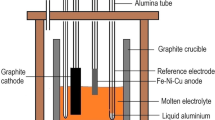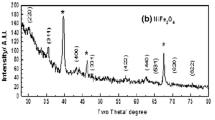Abstract
The potentio-dynamic polarization curves of pure Fe, Fe-30 Ni, and Fe-70 Ni alloys in acidic perchlorate solutions (pH 1.9) without and with 10−3 M Pb2+ were measured to investigate the effect of Pb-underpotential deposition (Pb-UPD) on anodic dissolution and passivation in relation to Pb-induced stress corrosion cracking (Pb-SCC) of Ni base alloys. The addition of 10−3 M Pb2+ shifts the open circuit potentials of pure Fe and Fe-Ni alloys toward noble direction to inhibit the anodic dissolution and promote the passivation, which results from Pb-UPD on substrate metals. The electro-desorption of Pb proceeds with anodic potential sweep and the anodic dissolution is enhanced when the surface coverage of Pb is reduced to a critical level. Tafel slopes (b + = 8.5∼15 mV decade−1) of anodic dissolution for pure Fe and Fe-Ni alloys in the presence of Pb2+ are significantly low as compared with those (b + = 34∼40 mV decade−1) in the absence of Pb2+, which reflects on the rapid enhancement in surface reactivity as a result of electro-desorption of Pb. It is found that the potential region in which anodic dissolution is inhibited by Pb-UPD is located within the potential window of Pb-UPD estimated from the differences in work-function between substrate metals and Pb.








Similar content being viewed by others
References
Staehle RW (2004) Proc. 11 th International Conference on Environmental Degradation of Materials in Nuclear Power Systems-Water Reactors. American Nuclear Society, p 381–424.
Staehle RW (2005) Proc. 12 th International Conference on Environmental Degradation of Materials in Nuclear Power Systems-Water Reactors, Minerals, Metals and Materials Society, p 163–1210.
Lu YC (2005) Proc. 12 th International Conference on Environmental Degradation of Materials in Nuclear Power Systems-Water Reactors. Minerals, Metals and Materials Society, p 1211–1219.
Lu BT, Luo JL, Yu YC (2007) J Electrochem Soc 154:C379–C389
Costa D, Talah H, Marcus P, le Cavar M, Gelpi A (1995) Proc. 7 th International Conference on Environmental Degradation of Materials in Nuclear Power Systems-Water Reactors. NACE, Houston, p 199–208.
Hwang SS, Kim JS (2002) Corrosion 58:392–398
Radhakrishnan H, Carcea AG, Newman RC (2005) Corros Sci 47:3234–3248
Seo M, Fushimi K, Habazaki H, Nakayama T (2008) Corros Sci 50:3139–3146
Kolb DM, Prazasnyski M, Gerischer H (1974) J Electroanal Chem 54:25–38
Kolb DM (1978) In: Gerischer H, Tobias CW (eds) Advances in electrochemistry and electrochemical engineering vol 11. Physical and electrochemical properties of metal monolayers on metallic substrates. John Wiley & Sons, New York, p 125–271
Herrero E, Buller LJ, Abruna HD (2001) Chem Rev 101:1897–1930
Lafranconi G, Mazza F, Sivieri E, Torchio S (1978) Corros Sci 18:617–629
Drazic DM, Vorkapic LZ (1978) Corros Sci 18:907–910
Jüttner K (1980) Werkst Korros 31:358–363
Seo M, Fushimi K, Aoki Y, Habazaki H, Inaba M, Yokomizo M, Hayakawa T, Nakayama T (2012) J Electroanal Chem 671:7–15
Koma A, Yagi M, Tsukada M, Aono M (1987) Handbook of surface physics technology. Maruzen Co. Tokyo, p. 535
Economy G, Speiser R, Beck FH, Fontana MG (1961) J Electrochem Soc 108:337–343
Condit DO (1972) Corros Sci 12:451–462
Heusler KE (1982) In: Bard AJ (ed) Encyclopedia of electrochemistry of the elements vol 9 a. Marcel Dekker Inc, New York, p 229–381
Brown IJ, Sotiropoulos S (2001) Electrochim Acta 46:2711–2720
Seo M, Hyono A, Habazaki H, Nakayama T (2014) J Electrochem Soc 161:C550–C556
Heusler KE, Gaiser L (1968) Electrochim Acta 13:59–60
Arvia AJ, Posadas D (1975) In: Bard AJ (ed) Encyclopedia of electrochemistry of the elements vol 3. Marcel Dekker Inc, New York, p 298–309
Rothschild JA, Eizenberg M (2010) Phys Rev B 81:224021–1-8.
Seo M, Sato N (1978) Corros Sci 18:577–589
Seo M, Sato N (1983) Oxid Met 19:151–163
Fain SC Jr, McDavid JM (1974) Phys Rev B 9:5099–5107
Ishi R, Matsumura K, Sakai A, Sakata T (2001) App Surf Sci 167-170:658–661
Author information
Authors and Affiliations
Corresponding author
Rights and permissions
About this article
Cite this article
Seo, M., Habazaki, H. & Nakayama, T. Effect of Pb-underpotential deposition on anodic dissolution and passivation of pure Fe and Fe-Ni alloys in acidic perchlorate solution. J Solid State Electrochem 20, 3133–3142 (2016). https://doi.org/10.1007/s10008-016-3210-y
Received:
Revised:
Accepted:
Published:
Issue Date:
DOI: https://doi.org/10.1007/s10008-016-3210-y




